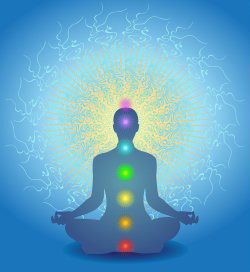Paid Services
About Kundalini Yoga & Chakras
Author: Vijay Pathak | Last Updated: Thu 25 Aug 2011 4:03:03 PM

The Chakras mentioned in the Tantric literature are six in number. These are independent units carrying on their assigned function. Each Chakra has Shakti controlling its own activity. In addition to these independent Shaktis of each Chakra there is a universal Shakti which has the power of controlling all these Chakras mentioned above. In the physical form she is lying dormant and coiled up like a serpent in an individual. When this is awakened by Yoga practices, the individual gains for himself the power of performing miracles.
The lowermost Chakra, with which Kundalini forms a connection and through which it is able to send impulses, is the Basic plexus called the Mulddkdra Chakra. It has four branches (Dala) and the shape of a triangle, or, in the words of the Garuda-Purana, the shape of the pudendum pubis (Bhaga). This description tallies very accurately with the description of the Pelvic plexus of the autonomic system, situated near the sides of the rectum. It is a continuation of the hypogastria plexus which bifurcates below into two lateral portions to assume the shape of a triangle; and by contemplation of this chakra the Yogi obtains freedom from disease, knows the past and the future and gains all psychic powers. It also forms connections with the Swadhisthana - the chakra which is situated in the pelvic region or Guhya-desha, just on a level with the root of the penis and is probably the hypogastric plexus.
The Swadhisthana Chakra has six petals or branches. By contemplation of this, freedom from death and disease is obtained. Higher up still, Kundalini forms herself into a plexus, which is known as the Kundali chakra or solar plexus and its location is in the region of the navel. Its direct extension upwards is called Manipura chakra, which can be identified with the plexus of the Coeliac axis. The proximity is so great that no distinction is made between the Kundali and Manipura chakras. The Kundali Chakra is described to be of a red color and to have ten branches. It is called the Lotus of Happiness. By contemplation of this chakra, a Yogi is able to enter into the body of another person; he obtains the power of transmuting metals, of healing the sick, and of clairvoyance. After passing through these Chakras the Kundalini forces its passage through the Anahata Chakra and which has twelve branches and is located in the Hridayadesha i.e. the region of the heart.
This description appears to identify itself with that of the Cardiac plexus of the sympathetic system. By contemplating this lotus, a Yogi becomes clairvoyant and clairaudient and is able to see adepts moving in the air, and gains the power of travelling at will to any part of the world by the exercise of his volition. Of the six important lotuses or plexuses, the one situated in Kantha, the region of the throat (Pomum Adami), known as Vishuddhi Chakra, has sixteen petals or branches. It is probably the pharyngeal plexus of the sympathetic; and it is said to be the lotus of purification. By contemplating this lotus, the whole body is purified of diseases and ailments and a Yogi is able to live a thousand years in external youth. In fact, he is dead to all the outer world, and becomes absorbed in his inner life. The power behind a malediction of a Yogi also depends upon the command of this lotus. Abstract scientific men are likely to laugh at the various powers assigned to the different plexuses. Still,, we have read of things in the ancient Vedic and classical literature which have been proved to be true, Reality of these achievements of a Yogi, time alone would show.
Kundalini then passes to the Taluka chakra i.e. the cavernous plexus of the sympathetic system which is situated at the base of the skull, and thence joins the Ajna chakra. This chakra is the Naso-ciliary extension of the cavernous plexus of the sympathetic through the ophthalmic division of the fifth cranial nerve, ending in the ciliary muscles of the iris and at the root of the nose, through the supra-orbital foramen. It has two petals or branches and is situated between the eyebrows- It is the spot which is contemplated while undergoing the process of Pranayama. Here is found the great light, the third eye as it is called, and by contemplation of this a Yogi gains wonderful psychic powers. This Chakra is called the plexus of command.
 Best quality gemstones with assurance of AstroCAMP.com More
Best quality gemstones with assurance of AstroCAMP.com More
 Take advantage of Yantra with assurance of AstroCAMP.com More
Take advantage of Yantra with assurance of AstroCAMP.com More
 Yantra to pacify planets and have a happy life .. get from AstroCAMP.com More
Yantra to pacify planets and have a happy life .. get from AstroCAMP.com More
 Best quality Rudraksh with assurance of AstroCAMP.com More
Best quality Rudraksh with assurance of AstroCAMP.com More
Get your personalised horoscope based on your sign.



















